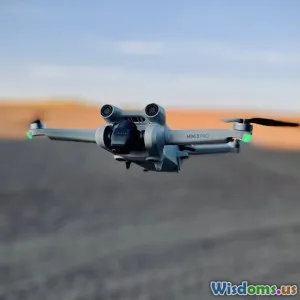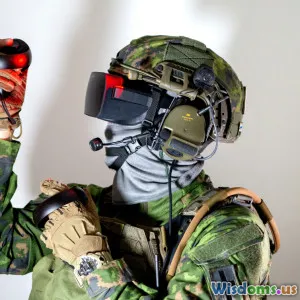
How Jamming Transforms Battlefield Communications Instantly
8 min read Explore how jamming technologies revolutionize battlefield communications, disrupting enemy signals and reshaping modern combat dynamics instantly. (0 Reviews)
How Jamming Transforms Battlefield Communications Instantly
Introduction
In the theater of war, communication is king. The flow of information between commanders and troops can dictate the difference between victory and defeat. Over recent decades, advances in electronic warfare have introduced a powerful weapon — jamming. This technology, which disrupts or blocks radio frequency communications, fundamentally transforms battlefield dynamics almost instantaneously. Understanding how jamming works and its impact on communication systems offers profound insights into contemporary and future warfare.
What Is Jamming?
Jamming refers to the deliberate emission of radio signals to interfere with the operation of enemy communication and radar systems. The goal is to deny, degrade, or deceive adversary communications, ultimately blinding their situational awareness and command capabilities.
Types of Jamming
- Noise Jamming: Overwhelms enemy receivers with high power noise signals, effectively drowning out legitimate communications.
- Deception Jamming: Sends false or misleading signals to confuse the enemy.
- Barrage Jamming: Covers a broad range of frequencies simultaneously, obstructing multiple communication channels.
- Spot Jamming: Focuses on a narrow frequency band typically used by the target’s communication systems.
How Jamming Instantly Changes the Battle
Immediate Disruption of Command and Control
Command and control (C2) are the backbone of military operations. Reliable communication channels allow commanders to relay orders, coordinate movements, and receive intelligence.
When jamming is introduced, these communications can falter or fail within seconds, leaving units isolated or unsure of the enemy’s disposition. For example, during the 2006 Lebanon War, Hezbollah’s sophisticated use of jamming technology reportedly disrupted Israeli forces’ communication lines, demonstrating how quickly battlefield coordination can be compromised.
Impact on Tactical Decision-Making
With communications jammed, the flow of intelligence halts. Commanders lose real-time situational awareness, increasing uncertainty and the probability of tactical errors.
A report by the U.S. Department of Defense emphasizes that “electronic jamming complicates command decisions, forcing commanders to rely on pre-established plans or autonomous unit actions, which may not adapt effectively to evolving conditions.” This instant disruption can alter entire battle plans on the fly.
Disruption of Friendly Communications
While jamming primarily targets the enemy, sophisticated systems can paradoxically impact friendly communications if coordination and frequency management are poor. Modern military forces often employ frequency hopping and encryption to minimize such risks.
Real-World Applications and Case Studies
The Gulf War and Electronic Jamming
Operation Desert Storm (1991) was one of the first large-scale demonstrations of electronic warfare’s potential. Coalition forces extensively used jamming to paralyze Iraqi radars and communication systems.
For instance, the AN/MLQ-36 and AN/MLQ-37 jammers helped deploy noise and deception jamming, confounding Iraqi defenses and allowing coalition air forces unprecedented freedom to operate. This reflected firsthand how jamming instantaneously changes the combat environment.
Modern Conflicts: Ukraine and Russia
The ongoing conflict in Eastern Europe has highlighted modern-day uses of electronic jamming. Both Ukraine and Russian forces apply jamming to block drones, communications, and GPS signals.
A leaked Ukrainian military report from 2022 illustrates how Russian jamming efforts degraded Ukrainian drone operations, leading Ukraine to develop counter-jamming tactics rapidly. This cat-and-mouse game underscores jamming’s immediate battlefield relevance.
Technological Mechanisms Behind Jamming
Signal Targeting and Frequency Management
Effective jamming requires identifying the target frequencies and delivering the interfering signals with enough power. Modern systems rely on:
- Signal Intelligence (SIGINT): To detect and classify enemy communication frequencies.
- Adaptive Jamming: Systems that automatically adjust frequency and power depending on the detected enemy signals.
Software-Defined Radios (SDRs) and AI Integration
Advancements in SDRs allow for much more flexible jamming capabilities. These radios can change operational parameters instantly, making it harder for the enemy to predict or counteract jamming.
Artificial Intelligence (AI) is being integrated to enhance signal recognition, improve targeting precision, and optimize jamming patterns in real time.
Countermeasures and Resilience
Frequency Hopping and Spread Spectrum
To combat jamming, many military radios use frequency hopping—constantly shifting frequencies according to pseudorandom sequences to evade jamming. Spread spectrum technologies also dilute signal power across a wide bandwidth, making jamming less effective.
Directional Antenna and Signal Authentication
Highly directional antennas can focus communication signals narrowly to avoid jamming noise. In parallel, modern systems employ cryptographic authentication to prevent deception jamming where false signals attempt to mislead forces.
Electronic Counter-Countermeasures (ECCM)
ECCM are techniques designed specifically to counteract jamming effects. They include advanced signal processing algorithms that filter out interference and maintain communication integrity.
For example, pilots and ground units use ECCM devices to preserve radar and communication channels during electronic warfare engagements.
How Jamming Shapes Future Warfare
Autonomous Systems and Jamming
As militaries increasingly deploy autonomous drones and robots, jamming becomes critical in blocking enemy autonomous systems dependent on radio control or GPS.
Reports indicate that China’s People’s Liberation Army actively develops jamming systems targeting GPS satellites and data links, highlighting an electronic arms race in controlling autonomous assets.
Cyber-Electronic Warfare Convergence
The blending of electronic warfare and cyber warfare creates new hybrid attacks, such as jamming combined with malware to destabilize adversary networks holistically.
Challenges and Ethical Concerns
While jamming can save lives by disrupting enemy operations, indiscriminate jamming risks affecting civilian infrastructure, such as emergency responders or communication networks. Navigating these ethical issues is a growing concern for military planners and governments.
Conclusion
Jamming technology instantly transforms battlefield communications by disabling or distorting enemy signals, fundamentally altering the pace and flow of modern combat. From disrupting command and control to undermining tactical advantage, jamming is a formidable tool in electronic warfare.
As adversaries continuously evolve their jamming capabilities and countermeasures, staying ahead requires integrating sophisticated technologies—like AI and software-defined radios—and maintaining flexible, resilient communication strategies.
Understanding the critical role of jamming not only informs military strategy but prepares defense ecosystems for the electronic battles shaping wars in the 21st century and beyond.
Sources & Further Reading:
- U.S. Department of Defense, "Electronic Warfare: Capabilities and Trends", 2021.
- GlobalSecurity.org, "Desert Storm Electronic Warfare Operations".
- Jane's Defence Weekly, "Electronic Warfare in Ukraine Conflict", May 2022.
- Smith, J., "Electronic Warfare and Communications Disruption", Military Communications Journal, 2020.
Rate the Post
User Reviews
Popular Posts


















